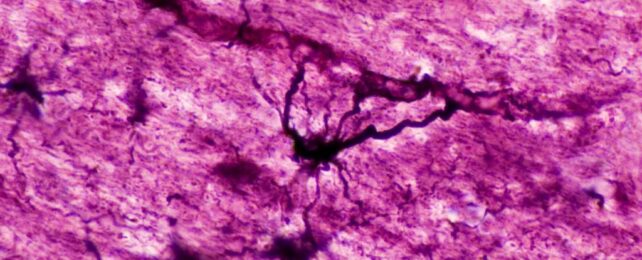An international team of scientists has found a whole new brand of brain cell hiding amongst neurons and their supporting units.
Surprisingly, the new cell type has characteristics of both, allowing it to serve an active role in neurological functions while still providing assistance to the nervous tissues around it.
Astrocytes are abundant cells in the brain that wrap around neuronal connections like 'glue'. For many years, neuroscientists assumed these cells were wholly passive, present only to protect neurons.
The field was revolutionized when evidence arose that astrocytes may contribute to neuronal 'firing' by secreting glutamate, the brain's main neurotransmitter.
But while studies in the lab suggest astrocytes are capable of releasing and absorbing glutamate, their role in a living, healthy brain is still being investigated.
In exploring that hypothesis further, researchers from various institutions in the United Kingdom and Europe have stumbled upon a radical hybrid cell in the brains of mice.
"In between neurons and astrocytes, we now have a new kind of cell at hand," says pharmacologist Andrea Volterra from the University of Lausanne in Switzerland (UCIL)
"Its discovery opens up immense research prospects."
Using single-cell RNA-sequencing, Volterra and his colleagues identified nine distinct clusters of astrocytes in the brain's hippocampus.
Cluster number 7 stood out. It was localized to very discrete parts of the brain's hippocampus, and possessed all the molecular machinery necessary to package up glutamate for release.
Using a type of glutamate imaging on living mice, the researchers found these specialized cells release glutamate at precise hotspots that were reminiscent of a synapse – the space where two neurons usually communicate by releasing glutamate.
"They are cells that modulate neuronal activity, they control the level of communication and excitation of the neurons," explains neuroscientist Roberta de Ceglia from UNIL.
When the research team disrupted these astrocyte-like cells, mice showed memory impairments.
Volterra says he and his colleagues are now planning future studies to explore the role of the hybrid cells in brain diseases like Alzheimer's, where memory is impaired.
"By uncovering this atypical subpopulation of specialized astrocytes in the adult brain, we provide insights into the complex roles of astrocytes in central nervous system (CNS) physiology and diseases, and identify a potential therapeutic target," the authors of the study write.
For now, the special cells are referred to as glutamatergic astrocytes – the first of their kind.
The study was published in Nature.
